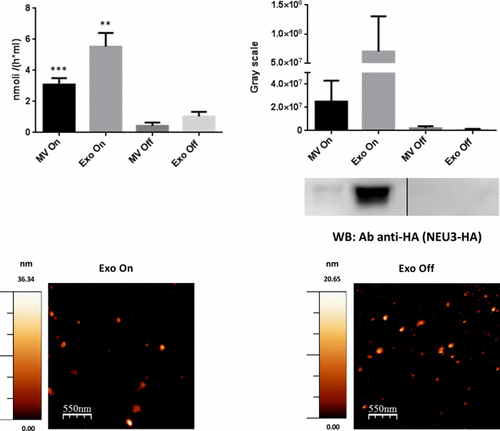当前位置:
X-MOL 学术
›
Biochemistry
›
论文详情
Our official English website, www.x-mol.net, welcomes your feedback! (Note: you will need to create a separate account there.)
Exosomes Secreted by HeLa Cells Shuttle on Their Surface the Plasma Membrane-Associated Sialidase NEU3
Biochemistry ( IF 2.9 ) Pub Date : 2017-10-27 00:00:00 , DOI: 10.1021/acs.biochem.7b00665 Lucia Paolini 1 , Flavia Orizio 1 , Sara Busatto 1 , Annalisa Radeghieri 1 , Roberto Bresciani 1 , Paolo Bergese 1 , Eugenio Monti 1
Biochemistry ( IF 2.9 ) Pub Date : 2017-10-27 00:00:00 , DOI: 10.1021/acs.biochem.7b00665 Lucia Paolini 1 , Flavia Orizio 1 , Sara Busatto 1 , Annalisa Radeghieri 1 , Roberto Bresciani 1 , Paolo Bergese 1 , Eugenio Monti 1
Affiliation

|
Sialidases are glycohydrolases that remove terminal sialic acid residues from oligosaccharides, glycolipids, and glycoproteins. The plasma membrane-associated sialidase NEU3 is involved in the fine-tuning of sialic acid-containing glycans directly on the cell surface and plays relevant roles in important biological phenomena such as cell differentiation, molecular recognition, and cancer transformation. Extracellular vesicles are membranous structures with a diameter of 0.03–1 μm released by cells and can be detected in blood, urine, and culture media. Among extracellular vesicles, exosomes play roles in intercellular communication and maintenance of several physiological and pathological conditions, including cancer, and could represent a useful diagnostic tool for personalized nanomedicine approaches. Using inducible expression of the murine form of NEU3 in HeLa cells, a study of the association of the enzyme with exosomes released in the culture media has been performed. Briefly, NEU3 is associated with highly purified exosomes and localizes on the external leaflet of these nanovesicles, as demonstrated by enzyme activity measurements, Western blot analysis, and dot blot analysis using specific protein markers. On the basis of these results, it is plausible that NEU3 activity on exosome glycans enhances the dynamic biological behavior of these small extracellular vesicles by modifying the negative charge and steric hindrance of their glycocalyx. The presence of NEU3 on the exosomal surface could represent a useful marker for the detection of these nanovesicles and a tool for improving our understanding of the biology of these important extracellular carriers in physiological and pathological conditions.
中文翻译:

HeLa细胞分泌的外泌体在其表面穿梭于质膜相关的唾液酸酶NEU3
唾液酸酶是从寡糖,糖脂和糖蛋白中去除末端唾液酸残基的糖水解酶。与质膜相关的唾液酸酶NEU3直接参与细胞表面含唾液酸的聚糖的微调,并在重要的生物学现象如细胞分化,分子识别和癌症转化中发挥重要作用。细胞外囊泡是细胞释放的直径为0.03–1μm的膜状结构,可以在血液,尿液和培养基中检测到。在细胞外囊泡中,外泌体在细胞间通讯和维持包括癌症在内的几种生理和病理状况中发挥作用,并且可能代表个性化纳米医学方法的有用诊断工具。利用HeEU细胞中NEU3鼠型的可诱导表达,已经进行了酶与培养基中释放的外泌体的缔合的研究。简而言之,NEU3与高度纯化的外泌体相关,并位于这些纳米囊泡的外部小叶上,如酶活性测量,蛋白质印迹分析和使用特定蛋白质标记物的斑点印迹分析所证明的那样。基于这些结果,似有可能的是,对外泌体聚糖的NEU3活性可通过修饰其糖萼的负电荷和位阻来增强这些小细胞外囊泡的动态生物学行为。
更新日期:2017-10-27
中文翻译:

HeLa细胞分泌的外泌体在其表面穿梭于质膜相关的唾液酸酶NEU3
唾液酸酶是从寡糖,糖脂和糖蛋白中去除末端唾液酸残基的糖水解酶。与质膜相关的唾液酸酶NEU3直接参与细胞表面含唾液酸的聚糖的微调,并在重要的生物学现象如细胞分化,分子识别和癌症转化中发挥重要作用。细胞外囊泡是细胞释放的直径为0.03–1μm的膜状结构,可以在血液,尿液和培养基中检测到。在细胞外囊泡中,外泌体在细胞间通讯和维持包括癌症在内的几种生理和病理状况中发挥作用,并且可能代表个性化纳米医学方法的有用诊断工具。利用HeEU细胞中NEU3鼠型的可诱导表达,已经进行了酶与培养基中释放的外泌体的缔合的研究。简而言之,NEU3与高度纯化的外泌体相关,并位于这些纳米囊泡的外部小叶上,如酶活性测量,蛋白质印迹分析和使用特定蛋白质标记物的斑点印迹分析所证明的那样。基于这些结果,似有可能的是,对外泌体聚糖的NEU3活性可通过修饰其糖萼的负电荷和位阻来增强这些小细胞外囊泡的动态生物学行为。


























 京公网安备 11010802027423号
京公网安备 11010802027423号